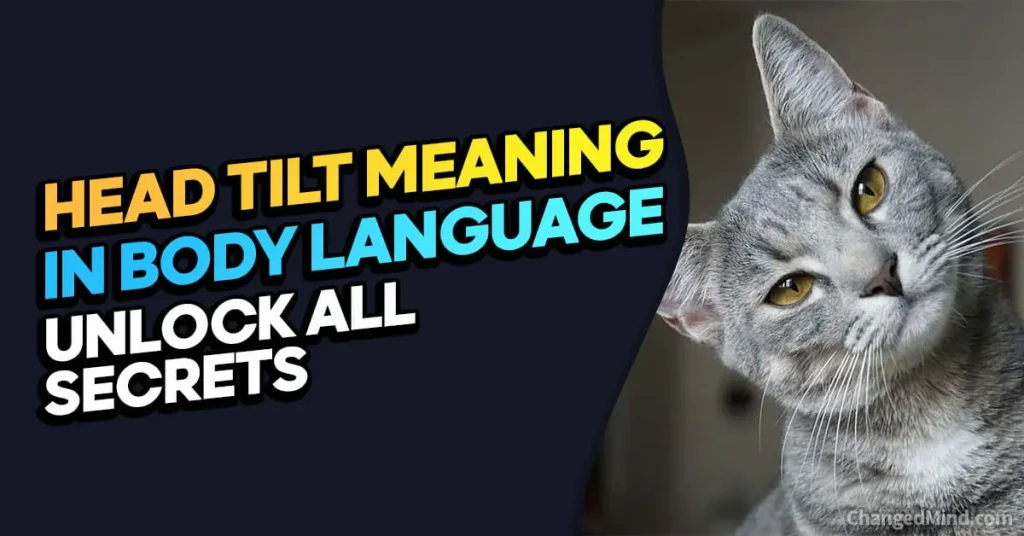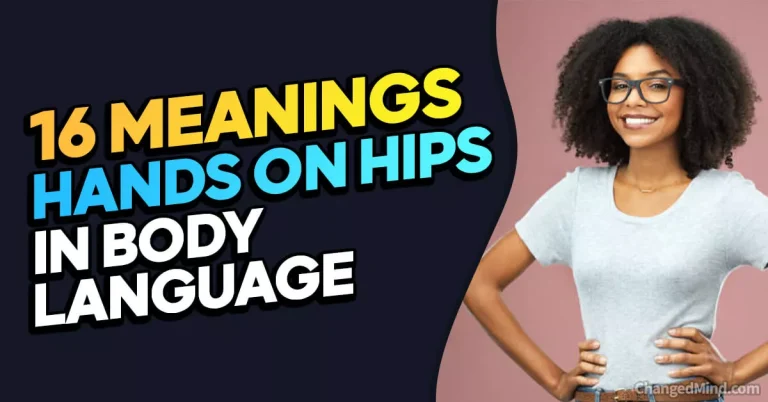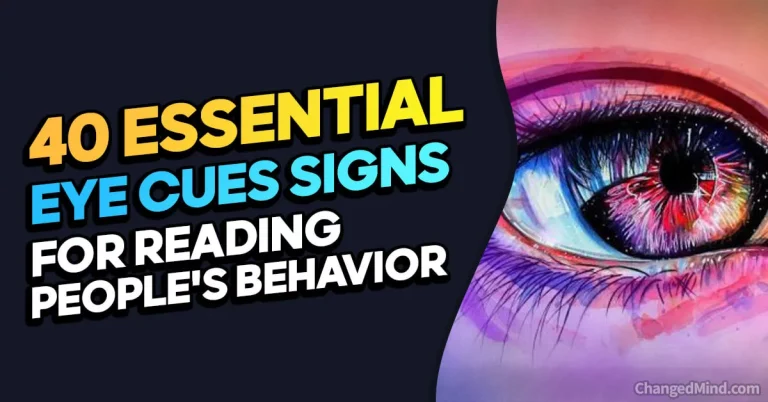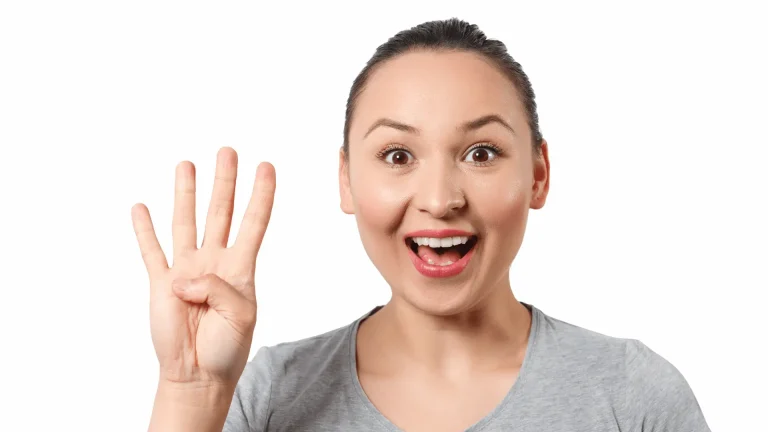Ever caught yourself in a conversation, tilting your head like a curious puppy? Guess what, you’re nonverbally speaking volumes!
This light-hearted exploration on the “Head Tilt Meaning In Body Language” is all about decoding this innocent gesture and what it conveys, from openness to curiosity, skepticism to submissiveness.
Dive in, we promise no stiff necks—just head-tilting insights about nonverbal cues, interpretation errors, and real-world applications. So, ready to become a gesture detective? Unravel the mystery one tilt at a time!
Key Points in the article:
- Understanding the basics of head tilt in body language.
- The significance of different types of head tilts: right, left, downward, and upward.
- Practical applications of understanding head tilt body language in personal relationships, professional situations, and negotiations.
- Common misinterpretations of head tilt and how to avoid them.
- The vital role of head tilt understanding in real-world scenarios.
Hello there, reader! Let’s embark on an enlightening journey into the realm of nonverbal communication. Just as a talented painter uses a myriad of colors to paint a masterpiece, we humans use a wide range of body language gestures to paint vivid pictures of our thoughts, emotions, and intentions.
Ever find yourself tilting your head when listening to a fascinating story? That’s your body talking! The head tilt meaning in body language is an exciting puzzle to crack. Why? Well, it’s like the Swiss Army Knife of nonverbal cues — versatile, often used, and deeply intriguing.
What is Body Language?
Body language is a crucial aspect of our day-to-day communication. It’s like a secret language that we all speak without uttering a word. Did you know that research suggests that nonverbal signals make up a whopping 55% of our overall communication? Now that’s something to ponder about!
From eye contact, facial expressions, to body posture, the realm of nonverbal communication is as expansive as it is complex. Decoding these silent signals can feel like deciphering ancient hieroglyphics, but don’t worry, we’ve got your back. We’re here to embark together on a mission to unearth the mystery behind one specific yet profound nonverbal cue – the head tilt.
Head Tilt Meaning In Body Language: A Gateway To The Mind
Every gesture, every blink, and, yes, every tilt of the head carries weight. In the labyrinth of body language interpretation, the meaning of a head tilt can be a significant game-changer. If eyes are the window to the soul, then head tilts could be the opening of the curtains. This subtle gesture can speak volumes, and when correctly interpreted, can offer profound insights into someone’s emotions, intentions, and subconscious signals.
Our quest here isn’t just about interpreting gestures; it’s about enriching our understanding of human communication and connecting more genuinely with people around us. Let’s delve deeper and decode the head tilt meaning in body language together. Brace yourselves for a roller-coaster ride into the fascinating world of body language analysis!
Understanding Body Language Basics
Before we dive headfirst (pun intended!) into the sea of understanding the head tilt meaning in body language, let’s dip our toes into the vast ocean that is body language.
The Nitty-Gritty of Body Language
Body language, or nonverbal communication, is a fascinating yet complex world. It’s like an invisible thread weaving its way through every interaction, forming a silent symphony of communication cues, gestures, and signals that orchestrate human relationships.
Let’s think of it this way: You’re a radio. Every time you interact with someone, you’re not only transmitting words (the spoken content of your radio station) but also a barrage of nonverbal signals (the music playing in the background). Body language works as an unspoken language that helps us express our true feelings and intentions without uttering a single word.
These nonverbal signals are delivered through a variety of ways: the furrow of your brow, the narrowing of your eyes, the slight twitch of your lips, the posture of your body, or even the tilt of your head. These subtle cues have a language of their own – one that we’re going to decode.
The Dance of the Head Movements
Have you ever noticed how much our heads move during conversations? From nodding in agreement, shaking in disagreement, to the mysterious tilt, our heads are in a constant dance of communication. In the realm of body language decoding, understanding head movements becomes crucial.
While nodding might indicate agreement and shaking the head often signals denial, head tilts are a whole different ball game. The subtlety of this movement often goes unnoticed in our everyday interactions. Still, once you learn to decipher it, it’s like having a secret decoder ring for understanding people’s nonverbal behavior better.
Each direction of a head tilt can represent a different emotion, intention, or subconscious signal. It’s the kind of nuance that adds a dash of intrigue to the science of body language interpretation. But why are head movements, and especially head tilts, so important?
Well, they often serve as a gateway to understanding complex nonverbal cues. Unraveling the head tilt meaning in body language can offer significant insights into the other person’s thoughts and feelings, allowing us to communicate more effectively. They are silent but powerful. So next time you’re having a conversation, pay attention to the dance of the head. It’s not just random movements; it’s a tale of human emotions waiting to be read.
In the following sections, we’ll dive deeper into the specific meanings associated with different types of head tilts. So, fasten your seatbelts and get ready for a ride into the fascinating world of body language gestures!
Deep Dive into Head Tilt Meaning in Body Language
The time has come to move from the shallow end to the deep end of our body language pool. Now that we’ve grasped the basics, let’s delve deeper into the specific nuances of the head tilt meaning in body language.
The Significance of Head Tilting in Human Communication
Head tilts aren’t just for adorable puppies trying to understand our human language. We, as people, also have a knack for tilting our heads, often subconsciously, during conversations. The role of a head tilt in human communication goes beyond just a cute quirk. It’s a subtle yet powerful tool that can dramatically affect the way our nonverbal cues are interpreted.
Understanding the head tilt meaning in body language can significantly enhance our nonverbal communication skills. It can help us decode subtle cues and signals that might otherwise go unnoticed. It’s like a silent secret code woven into our interactions, revealing layers of emotions and intentions that words might fail to express.
A head tilt can speak volumes, from showing interest and empathy to indicating confusion or even flirtation. Imagine having the power to decipher such diverse emotions with just one gesture! It’s like being a superhero of nonverbal communication. And who wouldn’t want that, right?
The Psychology Behind Head Tilting
Now that we’ve understood the role of head tilting, let’s peek into the mind’s enigma and explore the psychology behind this fascinating gesture. You see, when it comes to body language decoding, the mind is the puppet master, and the head tilt is just one of its marionettes.
Psychologically, a head tilt can be a manifestation of various cognitive and emotional processes. It could be a signal of empathy when we’re trying to understand someone’s point of view, a sign of confusion when something doesn’t quite add up, or even an indicator of attraction when someone has caught our fancy.
Neurolinguistic programming (NLP) experts often interpret a head tilt to the right as a sign that a person is ‘feeling’ rather than ‘thinking’. On the flip side, a tilt to the left can signify that a person is engaged in a more analytical or critical evaluation. Fascinating, isn’t it?
Moreover, research suggests that a tilted head can make a person appear more friendly or approachable. It’s like a nonverbal invitation that says, “I’m open to interaction.”
In essence, a head tilt isn’t just a physical motion. It’s a psychological phenomenon, a visual representation of our mental and emotional states. So, next time you find yourself tilting your head or notice someone else doing it, remember, there’s a lot more happening beneath the surface. Let’s unlock these secrets together as we continue our journey into the intriguing world of head tilt meaning in body language!
Different Types of Head Tilts and Their Meanings

Now that we’ve taken a dive into the deep end of the psychological pool, let’s splash around in the more practical puddles of head tilt meaning in body language. Remember, it’s not just about tilting your head; it’s about which way you tilt it. Let’s decipher the meaning behind right, left, downward, and upward head tilts.
Right Head Tilt Meaning
In the world of body language analysis, the right head tilt has its special place. Picture this: you’re deep in conversation with someone, and they tilt their head to the right. This could mean they’re processing their emotions or tapping into their creative side. Neurolinguistic programming (NLP) sees the right head tilt as a sign that the person is connecting with their emotions or intuitive thoughts. Maybe you’ve said something that’s stirred their emotional pot, or perhaps they’re about to come up with a groundbreaking idea!
Left Head Tilt Meaning
Now, if that head veers to the left, the signal changes. A left head tilt is often associated with critical thinking and analytical reasoning. The person is likely engaged in logical thought, perhaps weighing the pros and cons of your last statement or dissecting the hidden meaning in your words. It’s like the brain is rolling up its sleeves, ready to wrestle with rational thought. The left head tilt says, “I’m analyzing this. Give me a moment.”
Downward Head Tilt Meaning
Down we go to the downward head tilt. This one’s a bit tricky, as it can denote a range of emotions, from submission and insecurity to contemplation and introspection. A downward tilt might suggest the person feels overwhelmed or intimidated. But hold on, it’s not all doom and gloom! It can also be a sign of concentration, as if the person is trying to dig deep within their thoughts to find the perfect response to your insightful remarks.
Upward Head Tilt Meaning
Last but not least, the upward head tilt. It’s often seen as a sign of confidence, superiority, or even a challenge. Imagine someone leaning back slightly, tilting their head up, and locking eyes with you. That’s a nonverbal declaration of, “I’m confident in my stance.” However, like any good superhero, this power should be used wisely. An exaggerated upward tilt could come across as arrogance or dismissal, and we don’t want that, do we?
Remember, body language interpretation, including the head tilt meaning in body language, isn’t an exact science. It’s more of an art, where context, culture, and individual personality nuances play crucial roles. But with practice and keen observation, you’ll become a maestro of this silent symphony, gracefully orchestrating your way through the harmonious melodies of nonverbal communication. So, keep your eyes open, and let the silent conversations begin!
Practical Applications of Understanding Head Tilt Body Language
Gaining insights into the head tilt meaning in body language isn’t just an entertaining party trick; it has practical applications in various aspects of our lives. From personal relationships and professional interactions to the high-stakes game of negotiations and sales, your newfound understanding of nonverbal cues can give you the upper hand. So, buckle up as we journey into the world of practical head tilt application!
In Personal Relationships
Interpreting body language, such as a head tilt, can do wonders for your personal relationships. Understanding this nonverbal communication cue can lead to deeper connections and clearer communication with those around you. For example, when your partner tilts their head to the right while you’re sharing your day, they might be tapping into their emotional side, showing genuine interest in your experiences.
If a friend tilts their head downward while talking, they may be feeling vulnerable or introspective. Recognizing these subconscious signals allows you to respond more effectively, demonstrating empathy or providing reassurance when it’s most needed. It’s like you’ve unlocked a secret dialogue, enhancing your interactions on a whole new level. Now that’s a superpower worth having!
In Professional Situations
Move over, neckties and power suits, because the understanding of head tilt meaning in body language is the new must-have accessory in the professional arena. Imagine you’re giving a presentation, and you notice your boss tilting their head to the left. This could indicate they’re critically analyzing your proposal. Or, if during an interview, the recruiter tilts their head upward, it might suggest confidence in your abilities.
These subtle cues, when correctly interpreted, can provide invaluable feedback, allowing you to adjust your approach in real-time for more favorable outcomes. It’s like having a cheat sheet in the game of professional advancement, and who wouldn’t want that?
In Negotiations and Sales
Now, onto the exciting world of negotiations and sales, where every gesture counts. Mastering body language interpretation, particularly the head tilt, can make you a formidable negotiator or salesperson. Let’s say, in the middle of a negotiation, the other party performs an upward head tilt. This could signal confidence, a cue for you to up your persuasion game.
Or, imagine you’re in sales, and your client exhibits a right head tilt while you’re pitching a product. They might be connecting emotionally to your presentation, providing you with the perfect opportunity to close the deal.
In the high-stakes arena of negotiations and sales, understanding the head tilt meaning in body language can be the ace up your sleeve.
So, there you have it. By mastering the art of decoding the head tilt, you’re not just gaining an entertaining skill, but a practical tool that can significantly enhance your personal and professional interactions. Armed with this knowledge, you’re all set to conquer the silent yet profound world of nonverbal communication. And remember, practice makes perfect!
Common Misinterpretations of Head Tilt in Body Language
Just as you start feeling like an expert in head tilt meaning in body language, we must take a moment to address the potential pitfalls. Yes, even in the nuanced world of body language interpretation, there can be some common misinterpretations. Remember, a head tilt doesn’t always convey what we think it does. So, let’s untangle some of these common misconceptions to avoid getting lost in translation.
Avoiding Common Mistakes in Understanding Head Tilt
When decoding nonverbal cues like head tilts, it’s crucial not to jump to conclusions. Much like you wouldn’t declare a game of chess after the first move, body language analysis also requires patience and keen observation.
- Context is King: The same head tilt could mean different things in different scenarios. An upward head tilt at a meeting could indicate confidence, while at a rock concert, it might just mean someone’s trying to get a better view of the stage. It’s crucial to consider the context when interpreting body language.
- Individual Differences: People have unique quirks and habits. For instance, someone might have a natural tendency to tilt their head to the right, and it might not have anything to do with their emotional state. So, when analyzing body language, always consider individual differences.
- Cross-Cultural Considerations: Body language and its interpretations can vary across cultures. A gesture seen as a sign of openness in one culture could be considered disrespectful in another. So, in our global village, being culturally aware when interpreting gestures can prevent many faux pas.
- Look for Clusters: In the world of body language decoding, strength comes in numbers. A single gesture, like a head tilt, might not provide a full picture. Look for clusters of nonverbal cues for a more accurate interpretation.
So, in your journey to master the head tilt meaning in body language, remember to take these tips into account. Mistakes are part of the learning process, but with these pointers, you’ll be well-equipped to avoid the most common ones. Now, go forth, you budding body language decoder, and tilt your way to better communication!
What Does It Mean When A Woman Tilts Her Head To The Side?

Well, well, well, we’re back at it again! After dissecting the ‘head tilt meaning in body language’ among our furry friends, it’s high time we bring our focus back to humans – more specifically, women. So, you’ve seen her, the Mona Lisa of your local coffee shop, tilting her head as you speak. What could it possibly mean?
As seasoned interpreters of body language, you’re probably already aware that a head tilt can communicate a myriad of things. However, when a woman tilts her head to the side, a few common interpretations float to the top.
Firstly, she might be showing empathy or agreement. The head tilt is a universal nonverbal cue of understanding and solidarity. So, if she’s tilting her head while you’re recounting your worst coffee catastrophe, it’s likely she’s expressing empathy for your java-related misfortune.
Secondly, the head tilt can indicate interest and engagement. By tilting her head, she’s subtly signaling that she’s paying attention and is intrigued by what you’re saying. Whether it’s your discourse on your favorite microexpressions or your latest body language decoder gadget, her head tilt shows she’s into the conversation.
Finally, the head tilt can also be an unconscious flirtatious gesture, a way of showing vulnerability by exposing the neck and a certain softness in demeanor. However, remember that body language gestures can be incredibly nuanced and can vary based on context and individual differences.
But a word of caution as we continue to navigate the complex world of nonverbal cues: a single gesture should never be used to draw conclusions. The head tilt, combined with other body language signals like eye contact, facial expressions, or body posture, gives a more accurate picture.
In conclusion, the meaning behind a woman’s head tilt can range from empathy to interest, and sometimes even a little flirtation. Understanding these nonverbal communication cues can greatly enhance your communication skills. However, always remember the golden rule of body language interpretation: context is key. After all, body language is a lot like a jigsaw puzzle, and we’re just trying to put the pieces together. Happy decoding!
Why Do Dogs Tilt Their Heads When You Speak To Them?

Paws for a second, and let’s delve into the intriguing world of canine behavior. Isn’t it paw-sitively adorable when your furry friend tilts its head as you speak? This is an example of nonverbal communication, akin to the “Head Tilt Meaning In Body Language” in humans.
When your four-legged confidant tilts their head, they’re not just offering you a heart-melting Instagram moment; they’re trying to understand you better. In the world of nonverbal cues, a head tilt in dogs can be seen as a form of gesture analysis.
Believe it or not, this simple movement can have multifaceted interpretations, similar to the complexity of human body language interpretation. One popular theory is that dogs tilt their heads to adjust their pinnae, or outer ears, to better detect where sounds are coming from. This is part of their body language decoding system.
A second theory relates to sight. Dr. Stanley Coren suggests that the head tilt might help dogs make sense of our facial expressions, which are often hidden behind a muzzle from a dog’s eye-level perspective. By tilting their heads, dogs might get a better view of our faces and therefore, read our body language cues more effectively.
So, next time you speak to your canine companion and they respond with a charming tilt, remember it’s their version of body language analysis, akin to human nonverbal communication skills. Isn’t it barking brilliant? Remember, whether it’s interpreting gestures in humans or understanding why dogs tilt their heads, every bit of knowledge helps us communicate better with those around us.
But keep in mind, just as we discussed common misinterpretations of head tilt in body language earlier, canine behavior can be similarly misread. Always consult a behaviorist or vet for accurate information about your pet’s behaviors and signals. Keep tail-wagging, fellow dog lovers!
Why Do Cats Tilt Their Heads When You Talk To Them?

What’s the purr-pose of your feline friend’s head tilt? Just as we’ve navigated the complexities of “Head Tilt Meaning In Body Language” among humans, let’s swan dive into the world of feline nonverbal cues. Remember, a little ‘meow-nalysis’ can go a long way!
When your resident cat-burglar tilts their head as you chatter away, they might not just be contemplating their next ‘purrfect’ heist. Cats, too, have a rich repertoire of body language gestures, including the head tilt.
For starters, your cat might tilt their head as part of their body language decoding system. Cats are often trying to capture every detail of their environment. So, that head tilt might be your cat trying to pick up a specific sound or sight, similar to the canine interpretation we discussed earlier.
Another theory, in the context of feline body language interpretation, is that your cat could be expressing curiosity. Just like humans using nonverbal cues to show interest, a cat tilting its head could indicate that it’s engaged and eager to understand more about what you’re communicating.
However, bear in mind that a head tilt could also signal a medical issue, like an ear infection. So, if your cat frequently tilts its head, it might be time for a vet check. Remember, as we decipher nonverbal signals like the head tilt, the line between ‘curious cat’ and ‘concerned cat’ can be fine indeed.
To sum up, whether it’s the head tilt meaning in body language among humans, dogs, or cats, it’s important to understand that each species has its unique set of body language signals. It’s these subtleties in nonverbal communication skills that help us better understand and interact with our furry friends. So, keep these points in mind, and you’ll be a ‘purr-fect’ pet whisperer in no time!
Conclusion
As we draw our journey to a close, let’s quickly revisit the concept of the head tilt meaning in body language that we’ve dissected and analyzed throughout this post. It’s been quite the ride, hasn’t it?
Recap of the Main Keyword: Head Tilt Meaning in Body Language
Decoding the meaning of a head tilt in body language is akin to unwrapping a layered gift. We’ve discovered that the way a person tilts their head can tell you volumes about what they’re feeling, their intent, or how they perceive you.
From the friendly and open right head tilt to the more inquisitive left tilt, each direction offers unique insights into a person’s mind. The downward tilt, full of introspection and potential negative emotions, and the upward tilt, brimming with confidence or challenge, all contribute to the nuanced language of nonverbal communication.
However, don’t forget the potential misinterpretations and remember that the context, individual characteristics, cultural considerations, and other body language cues can greatly influence the interpretation of head tilts.
Final Thoughts and the Importance of this Understanding in Real-world Scenarios
Understanding the head tilt in body language is like having a secret decoder ring for human interactions. Whether you’re navigating a personal relationship, trying to excel in professional situations, or pushing for a win in negotiations and sales, interpreting these nonverbal cues can give you a leg up.
So, why not add this newfound knowledge to your communication toolkit? Remember, the human body speaks volumes if you know how to listen. And with this deeper understanding of head tilts, you’re well on your way to becoming a proficient body language decoder.
So, the next time you’re engaged in a conversation, watch the tilts. They might just tilt the conversation in your favor. Now, go forth, master your own body language, and start decoding the world around you. Keep your chin up! Or should I say tilted?
Key Takeaways
- The right head tilt typically indicates friendliness and openness.
- A left head tilt can suggest critical analysis or skepticism.
- The downward head tilt might imply introspection or possible negative emotions.
- An upward head tilt can convey confidence or a sense of challenge.
- Head tilt interpretation should always consider the context, cultural norms, and other nonverbal cues.
- Understanding the head tilt in body language can be a powerful tool in personal relationships, professional settings, and negotiations or sales.
- Misinterpretations can occur if you rely solely on head tilt as a communication cue.
FAQ
What does a right head tilt mean in body language?
The right head tilt is often associated with friendliness and an open attitude. It can indicate the person is interested in the conversation and trusts the other party.
How is a left head tilt interpreted in body language?
A left head tilt can suggest a more analytical or critical attitude. It might signal that the person is carefully examining the information being received.
What does a downward head tilt imply?
A downward head tilt can symbolize introspection, possibly negative emotions, or submissiveness. However, it can also indicate that the person is feeling shy or trying to show respect.
What does an upward head tilt mean?
An upward head tilt might convey confidence, challenge, or a sense of superiority. But, it could also imply curiosity or a questioning attitude, depending on the context.
Is head tilt always a reliable indicator of someone’s feelings or intentions?
While head tilts can offer clues, they should not be read in isolation. Other factors like context, cultural background, individual characteristics, and accompanying body language should be considered.







